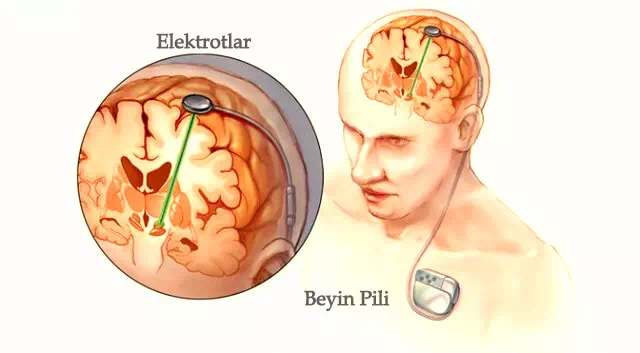Brain Pacemaker Treatment General Information
Brain pacing, or deep brain simulation as it is medically called, involves the surgical placement of a pair of electrodes in certain parts of your brain. Brain pacemaker surgery is a surgery that requires experience and the chances of success vary from patient to patient and from physician to physician. Electrical impulses are given to the brain to elicit therapeutic properties in some diseases by affecting certain cells and chemicals, to reduce the patient's use of medication, to reduce the to return to its original stages. For example, in Parkinson's disease, the effects of the disease may be minimal in the first years but gradually increase over the years. With brain pacemaker treatment, we aim firstly to reduce the effects of the disease on the patient and secondly to reduce the dependence on medication. In other words, after brain pacemaker treatment, our patients can return to 5-10 years ago in terms of the effects of the disease.

Which patients can undergo brain pacemaker surgery?
Brain pacemaker surgery is a method successfully applied in conditions such as dystonia, epilepsy, essential tremor, obsessive-compulsive disorder and Parkinson's disease. Brain pacemaker surgery is not a primary treatment option. Patients suffering from the above-mentioned diseases are first treated with medication. Brain pacemaker treatment is recommended in cases where drug treatment does not help, the progression of the disease is increasing gradually or the drugs cannot be used due to side effects. Again, if we give an example from Parkinson's disease, for example, patients who cannot maintain their normal life due to tremors, have severe seizures, and medications no longer reduce the condition, Patients who cannot even eat on their own, so to speak, can regain their health with brain pacemaker surgery. After the surgery, their tremors as a result of the decline in the number of people in the country.
Can a brain pacemaker completely cure the disease?
Brain pacemaker surgery does not completely cure the disease. Problems such as stiffness, rigidity, movement difficulties and difficulty walking, which are symptoms of the disease, are reduced, almost disappears. When the brain pacemaker is removed or turned off, the patient returns to his/her previous condition. Patient selection is very important for the success of brain pacemaker surgery. Patients in whom brain pacemaker treatment can be successful should be carefully selected. Not every dystonia, epilepsy or Parkinson's disease may respond to brain pacemaker treatment. Therefore, the determination of which patients can be treated and the success of the treatment is proportional to the experience and knowledge of the physician.
Is brain pacemaker surgery risky?
Brain pacemaker surgery is one of the least risky brain surgeries. There is a two to three percent risk of serious complications. The risk is minimal compared to the treatment. The biggest advantage of brain pacemaker treatment is that the battery can be adjusted after surgery according to the patient. Even if the probability is low, if any unfavorable situation occurs due to the brain pacemaker, the brain pacemaker can be closed from the outside. If necessary, it can be completely removed.
How is brain pacemaker surgery performed?
First of all, the brain map of our patient who will undergo brain pacemaker surgery is mapped with imaging methods such as MRI and computed tomography. Then, it is determined at which points stimuli called electrodes should be placed. The task of the electrodes is to detect pathological impulses. to produce electrical impulses that regulate the heart rate. This electrical stimulation is provided by a pacemaker-like device implanted under the skin in your upper chest. a device is used. In other words, this device is a kind of power source that sends electrical stimulation to the electrodes in the brain. Under your skin A wire connects this device, placed under the chest, to the electrodes in your brain. By adjusting the appropriate electrical activity via an external remote control optimization is achieved.
In brain pacemaker surgery, the electrodes placed in the brain are usually inserted under local anesthesia while the patient is awake. However, the physician's preference and the patient's condition It can also be performed under general anesthesia. Since it is performed under anesthesia, the patient will not feel any pain. The operation may take between two and five hours. Headache and dizziness may occur normally in the first few days after the operation. These pains will disappear after a while.
How long does a brain battery last?
Brain pacemakers last approximately five to six years. After five to six years, when the battery is exhausted, a new one is implanted with a short operation lasting between fifteen minutes and half an hour. replaced with a battery. The cables and electrodes in the brain are not touched.
When can I return to normal life after brain pacemaker surgery?
The average postoperative hospital stay is four to five days. Removal of stitches and full recovery takes up to one month. After this period, the patient can return to normal life. However, since the brain pacemaker is implanted, it is necessary to avoid possible movements such as falls, collisions and It is recommended to stay away from activities.
We have been successfully performing Parkinson's brain pacemaker surgeries for many years with a team that has a special interest in this subject. You can use our contact information for detailed information and appointments.